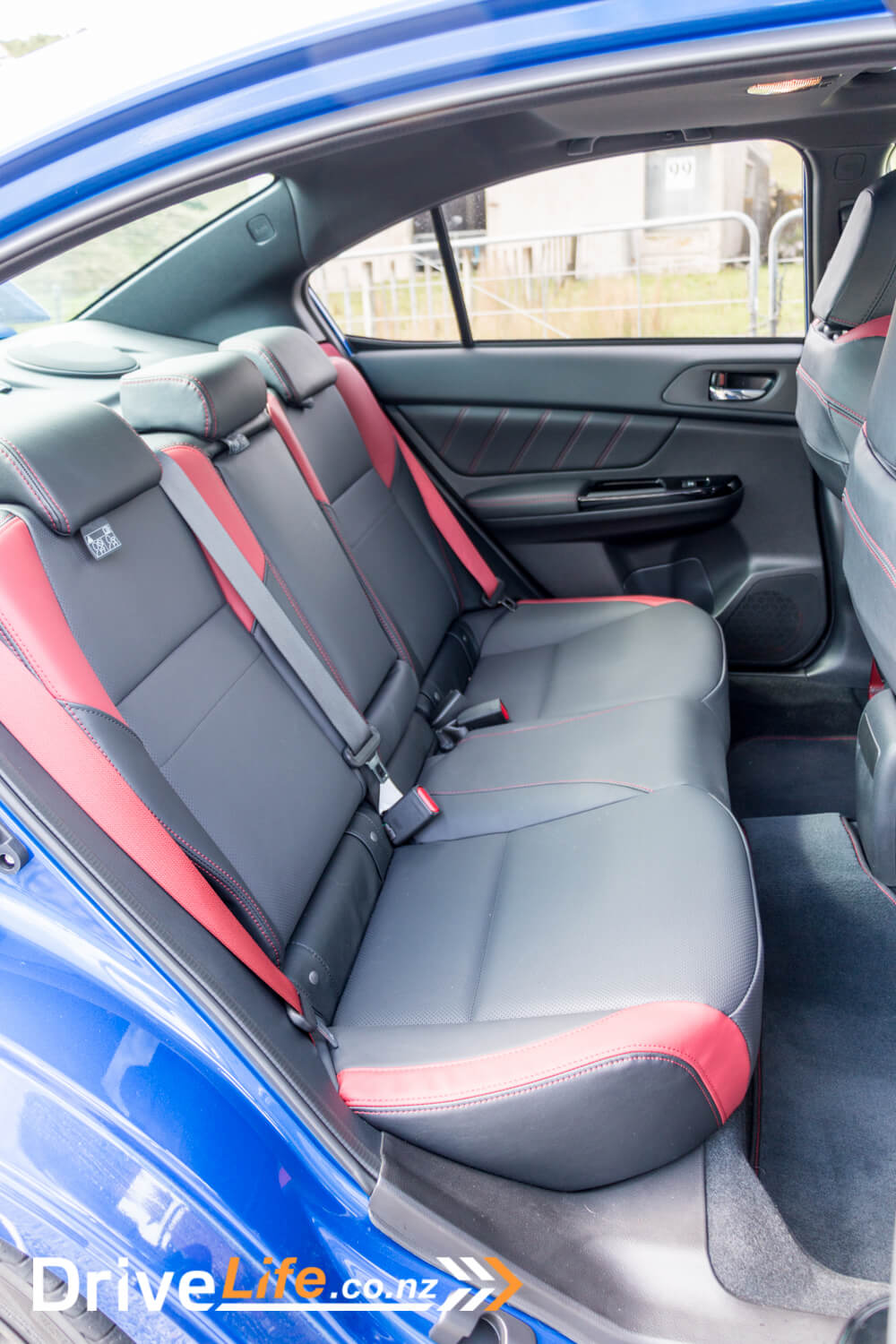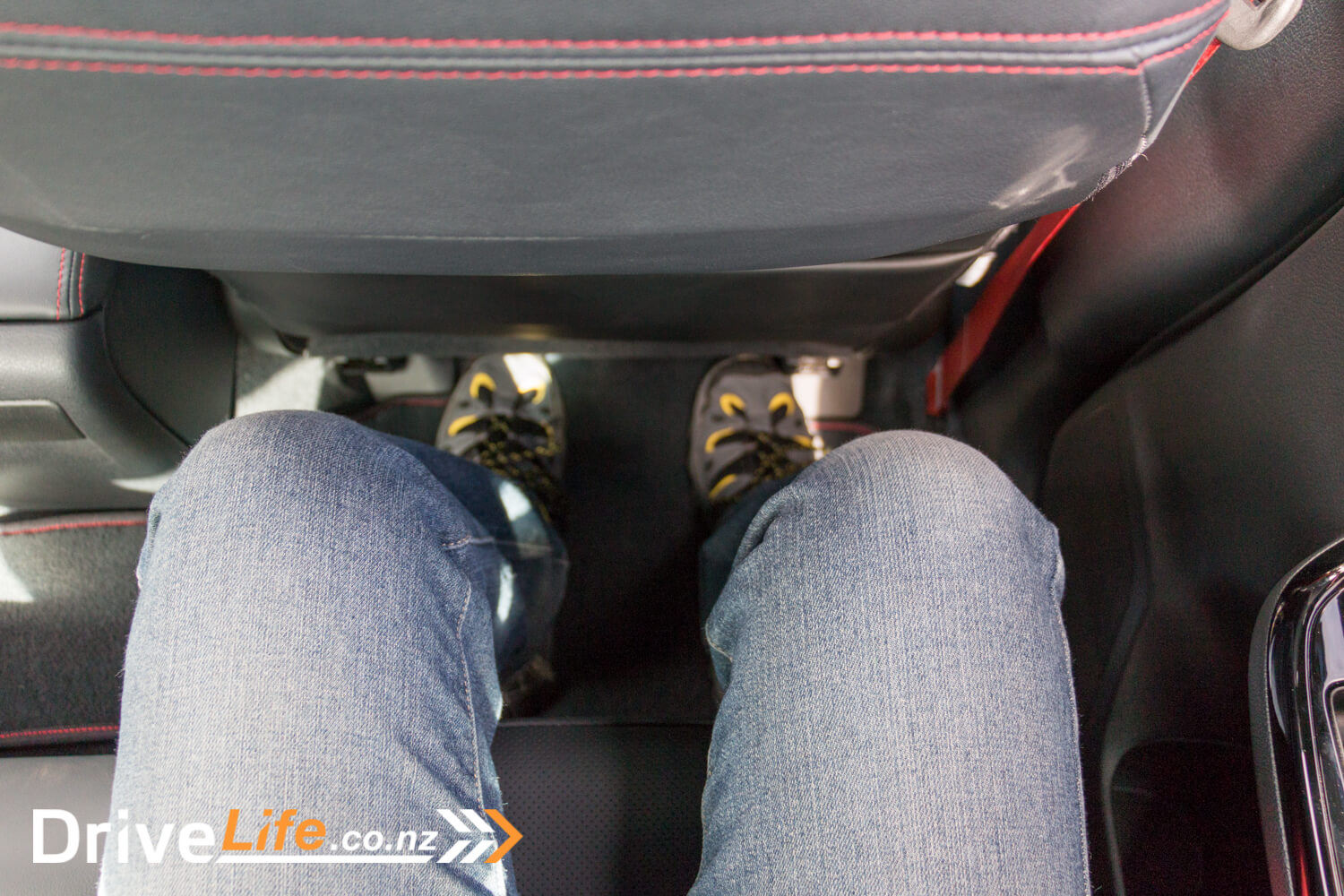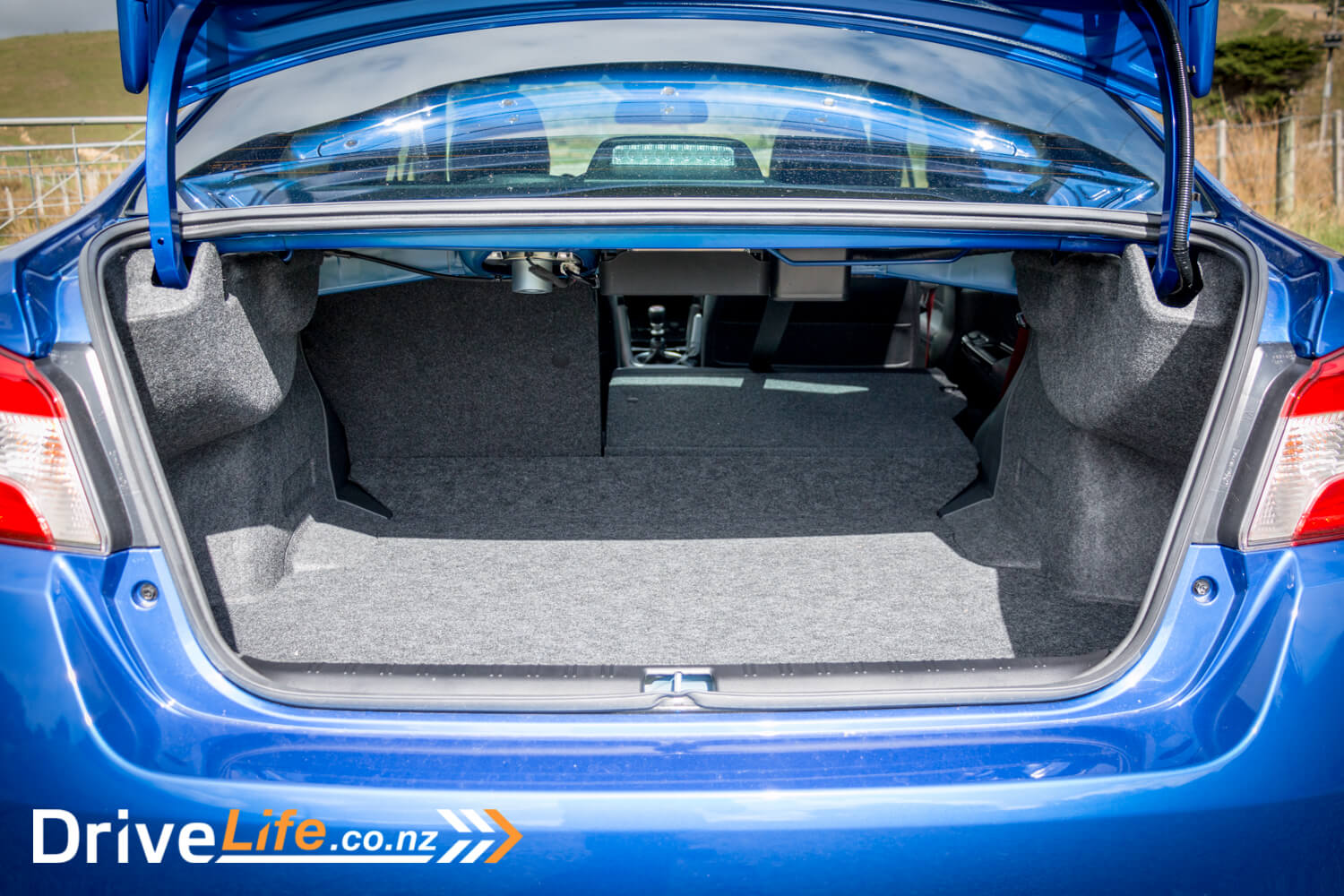The Subaru WRX STi has been around since the Impreza was given the performance treatment back in 2007. With the current generation, the Impreza and WRX are considered different ranges, and they have very different specs and personalities. We had a good time with the WRX few weeks ago and were looking forward to testing the STi version. Subaru sent us an STi Premium for a couple of weeks to find out what we thought.

The Range
In New Zealand there are four models: the WRX, WRX Premium, WRX STi, and WRX STi Premium. The details of the WRX are covered in our review here.
The STi starts at $59,990, and it’s well-specced. Power is provided by a 2.5-litre turbocharged boxer engine, making 221kW and 407Nm driving all four wheels via a six-speed manual transmission and an adjustable electronic centre diff. Features include seven airbags, ABD, EBD, ESC, Brake Assist, Traction Control, Active Torque Vectoring, 19” wheels, auto lights and wipers, LED headlights, dual-zone climate, alcantara and leather sports seats, satnav, 8 speaker Harman Kardon stereo, keyless entry and start.
For an extra $5,000 you can have the STi Premium, which adds full leather seats, electric sunroof, front camera, blind-spot detection, lane change assist, rear cross traffic alert, auto high beams, side view monitor, wiper with de-icer, front heated seats and 10-way power adjusted driver’s seat.
Seven colours are available: Crystal White Pearl, Crystal Black Silica, Lapis Blue Pearl, Dark Grey Metallic, Ice Silver Metallic, Pure Red, and the WR Blue Pearl you see here on our review car.

First Impressions
I first saw this car on display at Leadfoot Festival and hoped it would be the one we got to review. The classic Subaru metallic blue looks fantastic on this car, along with the dark wheels and day-glo yellow Brembo brake calipers. It looks sporty and aggressive without going too overboard on the details, (like a certain Honda, for example?). The classic STi big air scoop in the bonnet tells you it has some poke, and at the rear the quad exhaust tips, rear splitter and huge wing tell the same story. The wing is optional and can be replaced with a WRX-style lip spoiler, but I think it looks great and suits the design of the car both from the side and the front.

The Inside
The interior of the STi looks and feels very much like other current Subarus, and that’s definitely a good thing. The heated leather sports seats are comfortable, and the driver’s seat has 10-way electric adjustment with memory. The passenger has to make do with manual adjustment. The seats look fantastic, with red leather side trims and red stitching. The door cards, dash and steering wheel all have matching red stitching. Racy red seatbelts finish off the sporty look
The rear seats look just as good and are equally comfortable. Leg room is generous, but rear passengers don’t get any luxuries like power sockets or aircon vents.

The boot is a capacious 460 litres, and the 60/40 split rear seat backs fold flat to give you room to carry bigger items. There are no fancy things like bag hooks, power sockets or cargo hooks, which is surprising as things will definitely have a tendency to slide around the boot in this car! You might think that the weight of that huge wing would make the boot tricky to open, but either it’s really light, or the springs have been balanced perfectly, because it swings open with ease, and shuts with equal grace.
The dash uses Subaru’s now-familiar three display layout with the instrument binnacle, 8” central screen, and a third 5.9” widescreen central display just under the windscreen. The main cluster is a simple mostly-analogue layout with large rev counter and speedo, plus fuel and temp gauges. In the centre is a colour LCD for odometer, trip computer and centre diff setting displays.

The main screen is used for reversing camera, audio system, satnav and car settings. The third screen can be cycled through various gauges including boost gauge, fuel usage meters, wheel angle and drive display, and if you press the button below, it shows front and left-side camera views. The button is a bit of a reach for the driver, and though it’s logical for it to be near the screen it operates, it would be nice if it was closer.
The flat-bottomed steering wheel is adjustable in four directions, and is trimmed in perforated leather. It’s nicely shaped and a pleasure to use. Compared to the WRX they’ve reduced the number of buttons – down to 18. Fewer buttons are needed for the non-adaptive cruise control, and the SI-Drive controls have been moved to a knob by the gear lever. Also by the gear lever are controls to vary how open the centre diff is, and a traditional handbrake. The electronic parking brake is reserved for the automatic cars, and the STi is manual only.
The STi features an eight-speaker Harman Kardon audio system, with amplifier and subwoofer, and it’s very good indeed, with excellent bass and good clarity. Unusually these days there’s a CD player, as well as Bluetooth, USB and Aux inputs.

The Drive
Sitting in the STi with the key in your pocket triggers a startup animation on the dash, with red-lit needles sweeping across the dials before everything fades into visibility. It’s pretty cool. The engine start button has a red light until the clutch is depressed, when it turns green to say you can press it. Pressing that button made me grin every time, as the 2.5-litre boxer engine growled into life with that classic Subaru burble. The STi really does sound great, with that off-beat but also creamy-smooth sound. Wind the windows down and you realise that the STi sounds better on the inside than the outside. It makes sense, you want to enjoy the sound without annoying the neighbours.
My first experience of driving the STi was in very heavy rain, with standing water all over the motorway. Hardly the best conditions for a drive in a nearly-300bhp sports sedan, but the car felt solid and composed at all times. The speed limit was down to 60 on the motorway, so it was an ideal time to test the cruise control. The STi, being manual, doesn’t have all of the cameras and i-Sight systems that the WRX and Levorg have. This means you get standard non-adaptive cruise control, which is operated from steering wheel mounted buttons. It works well, displaying the set speed on the display as you’d expect, and doing its job simply and easily.

Back to normal weather the next day and it was time for the morning commute. The school run went well, with the bright blue car getting a fair bit of attention from the kids. They liked the day-glo brake calipers best. On the back way to the motorway, the STi’s character started to show through. This is a car that wants to be driven hard, all the time, and will reward you for doing so. Unfortunately it was rush hour, so into the heavy traffic I went. It soon became apparent that the STi doesn’t like to go slowly. The clutch is nice and light, but I found it very difficult to drive smoothly below 40-50kph. After 30 minutes of stop/start traffic I was starting to get a bit frustrated with it. Later, after consulting the manual, I tried adjusting the electronically-controlled centre diff to its most open setting and that seemed to help.
Another thing that can be annoying at low speeds is the ride. At higher speeds it feels really good, but when travelling slowly it feels rock-hard, and can be pretty jiggly over any bumps.

So it’s not a great commuter car. But this is a WRX STi: it’s built for the back roads or the track, not the daily grind. It wants you to drive it hard, all-out, all the time. And if you do, it will reward you well. Switch the drive mode into Sport#, and the revs raise slightly as though the car is tensing itself. Mash the throttle from a standstill, and the resulting acceleration is brutal. There’s no wheelspin, just a slight whine from the gearbox, that boxer growl, then the hiss of the turbo as the needle sweeps up to the red line. Clutch in, snick the tight, short throw gear lever into second, clutch back out and it leaps forward again, and you’ve hit 100 before you need third. It’s not smooth, but if you keep the STi on the boil it’s an absolute back-road weapon. The brakes are just as good, with 17” Brembos all-round: 6 pots at the front, 2 pots at the rear. The STi stops just as well as it goes. What about corners? The STi eats corners for breakfast! With symmetric four-wheel-drive, limited-slip diffs front and rear, and 245mm-wide Yokohama Advan Sport tyres, the STi will hang on to the road even if you pitch it into a corner at high speeds. If you really push it, understeer will eventually result, but a slight easing-off the throttle fixes it. The steering is quick, but doesn’t have as much of an accurate, pointy feel as the Civic Type-R.
The STi isn’t subtle, or smooth, it’s a monster that will eat up a twisty road, and you’ll cover the distance faster than you thought possible.

One thing that was a little surprising was the fuel consumption. Subaru quote 10.4 litres per 100km, which is fairly high for a manufacturer figure, especially as the STi needs 98RON or higher fuel. With a week of commuting and a couple of back-road runs I averaged 11.0l/100km. That’s much closer to the quoted figure than I expected.
After a few days with the STi I found myself developing a bit of a love/hate relationship with it. The low-speed ride continued to irritate me, but the engine sound constantly made me smile. The acceleration felt a little laggy at lower revs, but get it right and it was fantastic and grin-inducing. I loved the looks, the power, the handling, but if I got stuck in a traffic queue for a while, my difficulty in driving smoothly ticked me off. But overall there were way more pros than cons.

The Competition
| Brand/Model | Engine | Power/Torque | 0-100km/h, seconds | Boot Space, Litres | Fuel, L/100km | Price Highest to Lowest |
| Mercedes AMG A45 | 2.0l 4 cylinder turbo | 280kW/485Nm | 4.2s | 341 | 7.3 | $98,800 |
| BMW M240i | 3.0l 6 cylinder turbo | 280kW/500Nm | 4.6s | 390 | 7.1 | $91.600 |
| Audi S3 | 2.0l 4 cylinder turbo | 228kW/400Nm | 4.6s | 340 | 6.5 | $79,900 |
| Ford Focus RS | 2.3l 4 cylinder turbo | 257kW/440Nm | 4.7 | 316 | 8.1 | $72,990 |
| VW Golf R Manual | 2.0l 4 cylinder turbo | 228kW/400Nm | 5.1 | 343 | 7.1 | $72,890 |
| Subaru WRX STi Premium | 2.5 litre 4 cylinder turbo | 221kW/407Nm | 4.9 | 460 | 10.4 | $64,990 |
| Honda Civic Type-R | 2.0l 4 cylinder turbo | 228kW/400Nm | 5.7s | 420 | 8.8 | $59,900 |
| MINI John Cooper Works | 2.0l 4 cylinder turbo | 170kW/320Nm | 6.3s | 211 | 6.7 | $54,500 |
| Holden Astra VXR | 2.0l 4 cylinder turbo | 206kW/400Nm | N/A | 360 | 6.6 | $49,990 |

The pros and cons
| Pros | Cons |
|
|

What we think
If you’re after a car that’s fun, that you really have to put in some effort and drive, but need a reasonable amount of space and practicality, then the WRX STi might tick all of your boxes.
It has its disadvantages; that hard ride, and it doesn’t like to drive slowly. But if you give it your full attention and drive it like you’re meant to it will reward you with ferocious speed, and many grins.

Rating – Chevron rating (4.0 out of 5)
2018 Subaru WRX STi Premium
| Vehicle Type | Medium Sports Sedan |
| Starting Price | $59,990 plus on-road costs |
| Tested Price | $64,990 plus on-road costs |
| Engine | 2.5 litre DOHC turbocharged 4-cylinder boxer |
| Power Kw / Torque Nm | 221kW/407Nm |
| Transmission | 6-speed manual |
| 0 – 100 kph, seconds | 4.9 |
| Spare Wheel | Space-saver |
| Kerb Weight, Kg | 1537 |
| Length x Width x Height, mm | 4595 x 1795 x 1475 |
| Cargo Capacity, litres | 460 litres |
| Fuel Tank, litres | 60 |
| Fuel Efficiency | Advertised Spec – Combined – 10.4L / 100km
Real World Test – Combined – 11.0L / 100km Low Usage: 0-6 / Medium Usage 6-12 / High Usage 12+ |
| Towing | N/A |
| Turning circle | 11m
Small: 6-10m / Medium 10-12m / Large 12m+ |
| Warranty | 3 year unlimited kilometre warranty |
| ANCAP Rating | 5 stars |
































































